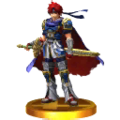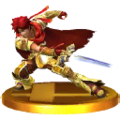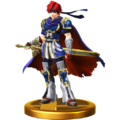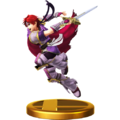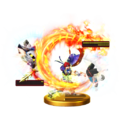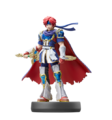Roy (SSB4)
| Roy in Super Smash Bros. 4 | |
|---|---|
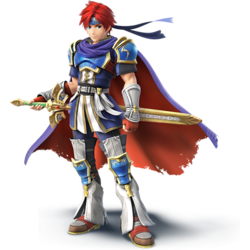 
| |
| Universe | Fire Emblem |
| Other playable appearance | in Melee |
| Availability | Downloadable |
| Final Smash | Critical Hit |
| Tier | G (50) |
| “ | Roy Seals the Deal! | ” |
| —Introduction tagline | ||
Roy (ロイ, Roy) is a playable character in Super Smash Bros. 4. Initially leaked through data mining of update 1.0.6, Roy was formally revealed after Lucas and released alongside him and Ryu on June 14th, 2015, making him the third downloadable character released and the final downloadable veteran. Jun Fukuyama reprises his role as Roy's voice actor, having new voice clips and ones that mimic those from Melee (rather than recycled ones from Super Smash Bros. Melee).
Roy is currently ranked 50th out of 58 on the SSB4 tier list, placing him at the bottom of the G tier. This is a slight drop from his previous placement in Melee, where he was ranked 20th out of 26, and makes him both the lowest ranking low-tier character and the lowest ranking DLC character. Two of Roy's greatest perks are his overall mobility and attack speed: his ground and air speeds are among the fastest in the game, while his attacks also boast quick start-up overall (with the exception of forward smash and down aerial), allowing him to react quickly to an enemy's openings. This complements Roy's inverse tipper mechanic, with large, easy-to-land sweetspots near the hilt of his Sword of Seals, while his fast maneuverability provides him many opportunities to deal powerful hits by simply being close to the opponent.
His combo game at low to medium percentages is also extremely damaging due to his throws, neutral attack and first hit of neutral aerial being able to set up into his other moves. Coupled with the power of his sweetspotted attacks, most of which are capable of KOing at realistic percentages despite their quick speed, Roy's throws and attacks are generally very rewarding to land, and he has no trouble sending damaged opponents off-stage.
However, Roy's playstyle is extremely risky due to several factors. Despite his speed, he has an ineffective approach due of his lack of a projectile. Furthermore, despite his very fast air speed, he has very slow air acceleration, forcing him to be committal to his approaches in general, and makes him very open to retaliation if he whiffs a move since he is unable to retreat once he begins an approach. Roy's inverse tipper also inadvertently gives him poor range for a swordsman, which is further compounded by his attacks having considerable ending lag and his aerial attacks being incapable of autocanceling from a short hop. Altogether, these traits render his moveset very punishable and unsafe on shield despite his overall power.
His throw combos are also inconsistent due to his throws' low hitstun, and his combo game past low percentages is poor, largely due to the knockback of his sweetspotted moves being too high to allow follow-ups. This makes him heavily reliant on reads and thus giving him few KO set-ups apart from his neutral attack and neutral aerial at high percentages. Finally, Roy has what is considered one of the worst recoveries in the game: Blazer's predictability and low vertical distance makes him vulnerable to semi-spikes, which is made worse by his very quick falling speed also making him an easy target to combo.
Overall, Roy is a "high-risk, high-reward" character who relies on finding openings using his speed before converging into highly damaging close range combos, while walling opponents out with fast attacks. However, he provides just as many openings to his opponent due to his attributes and laggy finishers, forcing to player to limit his approaches without being overly aggressive. As a result, he is not considered to have improved greatly from Melee, which is made worse by the fact that many of the characters that he was ranked ahead of in Melee, such as Mewtwo, Ness and Kirby, have been heavily buffed for their appearances in SSB4.
Due to these factors, Roy has infamously low tournament representation and lackluster competitive success, but his tier placement is highly debated within the community due to the recent appearances of several noteworthy results. Most notoriously, Ryo managed to win two games against Abadango's Mewtwo, who is considered the best player of Mewtwo, at Super Smash Con 2016; this resulted in Abadango choosing Rosalina & Luma as a counterpick despite the wide tier gap between the low-tier Roy and top-tier Mewtwo and Rosalina & Luma. While this instance has not been sufficient enough to significantly raise Roy's tier placement as of the second official tier list, several professionals believe that Roy's abilities are underrated and that he deserves a higher placement on the tier list. One example is ZeRo, one of the best SSB4 players in the world, who views Roy as a mid-tier character rather than a low-tier character.
Attributes
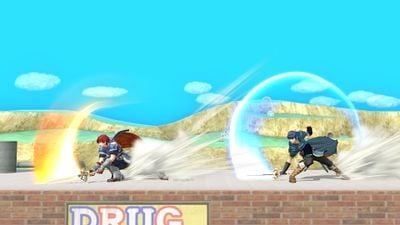
Roy is a semi-clone of Marth, sharing a handful of moves with him; however, Roy has an individualized playstyle thanks to certain mechanical differences, the most notable of which is his inverse tipper: the Sword of Seals deals more damage and knockback near its hilt, and much less at the blade's tip. Like Marth, Roy is a middleweight, but his other attributes are entirely different: Roy has better mobility, thanks to his an above average walking speed, the eleventh fastest dashing speed, the fourth fastest air speed, and the fifth fastest falling speed. His fast movement speed also gives him an effective extended dash-dance, allowing him to read and punish opponents accordingly. However, Roy is tied for the longest initial dash animation (17 frames), giving him a poor shield buffer out of his dash, and his air acceleration is among the slowest in the game, forcing him to commit to any aerial approaches and makes his aerial movements significantly less fluid compared to Marth, who's air acceleration allows him to attack and retreat at the same time.
Roy's attacks generally have quick start-up, and his high speed allows him to easily get close to his opponent. Once Roy finds an opening, he has several ways to rack up damage. His neutral aerial is perhaps his most versatile move, thanks to its low start-up and landing lag, long-lasting hitbox, and utility as a combo starter. His neutral attack is quick and can easily lead into other moves, including his throws and tilts. He also possesses a good spacing and shield stabbing move in his down tilt. His down and forward throws launch opponents at favorable angles, opening up combo opportunities for his neutral attack, dash attack, forward tilt, neutral aerial, and Double-Edge Dance. His inverted sweetspot also benefits him. Since it is much larger than Marth's sweetspot, he on average deals higher damage more reliably from his combos (and in general) than Marth, who requires meticulous spacing for the same effect.
Despite his speed, Roy boasts an array of KOing options, with many of his sweetspotted attacks capable of KOing below 130%. His attacks are also less polarizing than Marth's, as most of them include an additional hitbox that is between both the sweetspot and sourspot, and so Roy does not require precise spacing to reliably land a KOing blow. While on the stage, his best KOing options are his forward tilt, forward smash, up tilt and Blazer, due to their fast start-up and high power. Blazer is additionally an excellent out of shield option, granting him super armor on start-up, and can stage spike careless opponents who attempt to edgeguard him. His disjointed hitboxes lend themselves to an effective off-stage game. His forward and back aerials are quick and cover wide arcs, while his down aerial is a reliable meteor smash. Flare Blade is deadly against opponents who try to sweetspot the edge, courtesy of its charging ability, incredible power, huge hitbox, and deceptively low ending lag. His Counter is also one of the strongest in the game, as its 1.35x damage multiplier makes it devastating if used against a powerful attack. Roy's average weight and fast falling speed give him strong on-stage endurance, and he can make great use of rage, which further enhances the knockback of his already powerful moves.
However, Roy is greatly hindered by a slew of flaws. While his hilt mechanic is one of his greatest strengths, it also forces him to fight extremely close to his opponent in order to be utilized to its fullest. This is made unsafe by his range being decidedly short for a sword fighter, resulting in a whiffed move on Roy's part leaving him heavily open to punishment. His moves have high ending lag, and so when combined with his need to fight close, Roy cannot space out his opponents as effectively as other sword-wielding characters, while also being unable to safely rush down his foes. He also suffers from a predictable approach despite his good mobility, since he has no quick options with which to close in and pressure the opponent outside of his neutral aerial, and this is made worse by his lack of a projectile. His very fast air speed is offset by his very slow air acceleration, making his aerial approach highly committal in general, much like Ryu's.
Roy's combo game is dangerous early on, with his follow-ups being strong and versatile at low percents. He has many decent combo starters, like his neutral attack, neutral aerial, up aerial, down throw and forward throw. However, unlike Marth, the sourspots of Roy's moves are not as reliable at creating combos; although they are still possible to perform, the sourspots require a lot of emphasis on precision in Roy's combos and can cause them to quickly lose their effectiveness. The high ending lag of Roy's moves and the low hitstun of his forward and down throws, the former of which is further compounded by the fact that most opponents can reliably tech out of its follow-ups, all hinder Roy by opening holes in his combo game due to them occasionally making it so that he has to attempt to read what his opponent will do. While Roy can combo decently past medium percents and up to high percents, most of these combos are limited.
In spite of his high maneuverability, Roy's recovery is somewhat notorious for its ineffectiveness. Although Blazer offers excellent protection, can be angled, and grants decent horizontal distance, it gives little vertical recovery and can be easily predicted. When combined with his high falling speed, this leaves him highly susceptible to meteor smashes, while even a sufficiently strong semi-spike can launch him too far away to recover. Additionally, players unaccustomed to his falling speed will quickly find that any misused aerial off-stage will send him too far off-stage to recover.
Roy's high falling speed causes another problem: he is very susceptible to combos while on-stage. His unsafe moves offer opponents many opportunities to punish him, and none of his moves are generally reliable enough to consistently break combos. Because of this, many characters with reliable combo moves can rack up large amounts of damage and easily force him off-stage, where he could potentially lose his stock if dealt with accordingly. Finally, due to his status as a DLC character, Roy does not have any custom moves, significantly hurting him in tournaments allowing them; while this is a problem shared with other DLC characters, it arguably affects Roy the most due to the comparatively low utility of his special moves.
Overall, Roy has as many weaknesses as he has strengths. While commonly viewed as falling under the rushdown and/or glass cannon archetypes, Roy instead relies on limited aggression, playing around an opponent's shields and reactions using his excellent speed, and finding a single opening in which to capitalize on. From there, he can dominate opponents with his decent combo game and threatening finishers, although he cannot be too overzealous due to his own vulnerability to combos from faster characters, as well as a poor recovery and short range for a swordsman.
Despite initially being viewed as a viable high-tier character and possibly the best swordsman in the game, Roy has become infamous for his poor tournament representation, as he sees little use from professional players aside from All Might, Ryo and Sethlon. This in turn has resulted in him being lacking in noteworthy results.
Changes from Melee
Roy is frequently placed within a group of characters (Bowser, Dr. Mario, Charizard, King Dedede and Pit) that are the most noticeably reworked veterans in SSB4. In Roy's case, several of his moves were de-cloned from Marth, to the point that he is now a semi-clone instead of a full clone. Roy is generally considered to have been buffed from Melee, however, changes to game physics as well as other nerfs have also harmed him.
Among Roy's buffs are his greatly improved mobility, now having a faster dashing speed and one of the fastest air speeds in the game, as well as his moveset being notably more rewarding than in Melee: most of his moves are different from Marth, such as his new neutral attack, forward and up tilts, dash attack and down aerial, all of which improve his up close and combo games, and many of which are more reliable KO moves. His damage output is higher, and his sweetspotted attacks are considerably more powerful, giving him a bevy of new KOing options, which generally alleviates his main weakness from Melee. His attack speed is faster overall, with his aerials in particular having significantly reduced ending and landing lag, L-canceling notwithstanding. Lastly, the addition of rage, along with his heavier weight, boosts his KO power even further should he survive to high percents. Roy's recovery is generally better, thanks to Blazer's improved horizontal distance, his faster air speed and the introduction of edge trumping.
However, Roy has also received significant nerfs. Roy now stands at Marth's height, which enlarges his hurtbox, though his attacks have much shorter reach and hitbox durations in spite of this, forcing him to fight even closer to the opponent, exacerbating one of his key weaknesses in Melee. For the most part, Roy is also harmed by the post-Melee gameplay changes: the loss of wavedashing and L-canceling, as well as the weakening of dash-dancing, noticeably worsen his approach. The general increase in range for other characters since Melee, such as with Donkey Kong and Bowser, also indirectly hurts him. Double-Edge Dance's first hit has almost completely lost its ability to stall his descent due to Roy's increased falling speed, which hurts his recovery. Along with the removal of meteor canceling and the improved recoveries of the rest of the cast, Roy is arguably easier to edgeguard than in Melee, despite his improved recovery. Finally, despite the slower falling speeds in the game compared to Melee, Roy is still easy to combo, since he is heavier than in Melee. As a result of the previous two changes, Roy's overall survivability is slightly worse than in Melee.
Overall, both Roy's strengths and weaknesses are more pronounced than in Melee. While his sweetspotted attacks are more rewarding, he has to fight even closer in order to rack up damage due to his decreased range, while his sub-par survivability makes his playstyle highly risky. Due to this, it is difficult to say how much Roy has improved from Melee, and while he has been improved since said game, other returning veterans were also buffed to varying degrees.
Aesthetics
 Roy's design is now a combination of his appearance as a Great Lord in Fire Emblem: The Binding Blade and his appearance as an Einherjar in Fire Emblem Awakening. He also has smaller eyes, a slightly more muscular physique, and slightly shorter hair.
Roy's design is now a combination of his appearance as a Great Lord in Fire Emblem: The Binding Blade and his appearance as an Einherjar in Fire Emblem Awakening. He also has smaller eyes, a slightly more muscular physique, and slightly shorter hair. Roy has more exaggerated facial expressions. He makes more prominent scowls during some attacks and even clenches his teeth in a few of them.
Roy has more exaggerated facial expressions. He makes more prominent scowls during some attacks and even clenches his teeth in a few of them. The Sword of Seals' trail now clearly indicates its sweetspot at its hilt, similarly to Falchion's trail showcasing its sweetspot on its tip.
The Sword of Seals' trail now clearly indicates its sweetspot at its hilt, similarly to Falchion's trail showcasing its sweetspot on its tip. Roy now swings the Sword of Seals in a reverse grip or with both hands. As a result, Roy's Sword of Seals now appears "heavier" compared to Marth's Falchion and Lucina's Parallel Falchion, which they appear to swing with less effort.
Roy now swings the Sword of Seals in a reverse grip or with both hands. As a result, Roy's Sword of Seals now appears "heavier" compared to Marth's Falchion and Lucina's Parallel Falchion, which they appear to swing with less effort. Roy now has an on-screen appearance. He appears via warp magic with the Sword of Seals stuck in the ground, after which he pulls it out.
Roy now has an on-screen appearance. He appears via warp magic with the Sword of Seals stuck in the ground, after which he pulls it out. Roy now has unique idle poses, rather than variations of Marth's. However, he has the same stance as Marth while holding a light item.
Roy now has unique idle poses, rather than variations of Marth's. However, he has the same stance as Marth while holding a light item. Jump, sidestep, and shield break animations have changed.
Jump, sidestep, and shield break animations have changed.
Attributes
 Roy is taller, as he now stands at Marth's height. This makes his hurtbox larger. Additionally, while this would improve his overall range, this is largely mitigated by the aforementioned alterations to his sword swings making many of his attacks having smaller hitboxes and altered hitbox placements.
Roy is taller, as he now stands at Marth's height. This makes his hurtbox larger. Additionally, while this would improve his overall range, this is largely mitigated by the aforementioned alterations to his sword swings making many of his attacks having smaller hitboxes and altered hitbox placements. Roy is heavier (85 → 95). This improves his endurance, but makes him more susceptible to combos.
Roy is heavier (85 → 95). This improves his endurance, but makes him more susceptible to combos. Roy walks slower (1.2 → 1.15).
Roy walks slower (1.2 → 1.15). Roy dashes faster (1.61 → 1.95).
Roy dashes faster (1.61 → 1.95). Roy's air speed is faster (0.9 → 1.24).
Roy's air speed is faster (0.9 → 1.24). Roy falls slower (2.4 → 1.8), although he still has the fifth fastest falling speed in the game.
Roy falls slower (2.4 → 1.8), although he still has the fifth fastest falling speed in the game. The removal of wavedashing and L-canceling and the weakening of dash-dancing have hindered Roy's neutral and approach games.
The removal of wavedashing and L-canceling and the weakening of dash-dancing have hindered Roy's neutral and approach games.
Ground attacks
 Roy has a new neutral attack, a reverse gripped upward slice. Compared to the previous neutral attack, it deals more damage (3%/5%/6% → 4.8%/7.5%/7.5%) and base knockback (30/5 → 40/32), has less ending lag (interruptibility frame 26 → 23) and it has a different angle (361° → 62°/32°). Altogether, these traits make it better for combos.
Roy has a new neutral attack, a reverse gripped upward slice. Compared to the previous neutral attack, it deals more damage (3%/5%/6% → 4.8%/7.5%/7.5%) and base knockback (30/5 → 40/32), has less ending lag (interruptibility frame 26 → 23) and it has a different angle (361° → 62°/32°). Altogether, these traits make it better for combos. Neutral attack has more start-up lag and its duration is 2 frames shorter (frame 4-8 → 5-7) compared to the previous neutral attack.
Neutral attack has more start-up lag and its duration is 2 frames shorter (frame 4-8 → 5-7) compared to the previous neutral attack. Roy has a new forward tilt, a reverse gripped downward slash. Compared to the previous forward tilt, it deals more damage (12%/10%/7% → 12.5%/9%/8%) and knockback (60/30 (base)/70 (scaling) → 30/40 (base)/100/80 (scaling)) and has less start-up (frame 9 → 8) and ending lag (interruptibility frame 40 → 32). Altogether, these traits making it better for KOing.
Roy has a new forward tilt, a reverse gripped downward slash. Compared to the previous forward tilt, it deals more damage (12%/10%/7% → 12.5%/9%/8%) and knockback (60/30 (base)/70 (scaling) → 30/40 (base)/100/80 (scaling)) and has less start-up (frame 9 → 8) and ending lag (interruptibility frame 40 → 32). Altogether, these traits making it better for KOing. Forward tilt's duration is 2 frames shorter (5 frames → 3) compared to the previous forward tilt.
Forward tilt's duration is 2 frames shorter (5 frames → 3) compared to the previous forward tilt. Roy has a new up tilt, a reverse gripped overhead arcing slash. Compared to the previous up tilt, it deals more damage (6%/8%/9%/10% → 7%/12%), making it much stronger than the previous up tilt despite having less knockback scaling (120/118/116/100 → 103). It also has less start-up (frame 7 → 6) and ending lag (interruptibility frame 40 → 39) and its sourspot has more base knockback (20 → 30). Altogether, these traits make it better for KOing and combos.
Roy has a new up tilt, a reverse gripped overhead arcing slash. Compared to the previous up tilt, it deals more damage (6%/8%/9%/10% → 7%/12%), making it much stronger than the previous up tilt despite having less knockback scaling (120/118/116/100 → 103). It also has less start-up (frame 7 → 6) and ending lag (interruptibility frame 40 → 39) and its sourspot has more base knockback (20 → 30). Altogether, these traits make it better for KOing and combos. Up tilt's duration is 2 frames shorter (7 frames → 5) compared to the previous up tilt.
Up tilt's duration is 2 frames shorter (7 frames → 5) compared to the previous up tilt. Sweetspotted down tilt deals 1% less damage (12% → 11%).
Sweetspotted down tilt deals 1% less damage (12% → 11%). Sourspotted down tilt deals 0.5% more damage (6% → 6.5%).
Sourspotted down tilt deals 0.5% more damage (6% → 6.5%). Down tilt has decreased start-up lag (frame 8 → 7) and its angle has been altered (80° → 30°), improving its edgeguard and tech-chase potentials and granting it the ability to semi-spike.
Down tilt has decreased start-up lag (frame 8 → 7) and its angle has been altered (80° → 30°), improving its edgeguard and tech-chase potentials and granting it the ability to semi-spike. Down tilt has decreased base knockback (90/70 → 50/40), increased ending lag (interruptibility frame 20 → 22) and its duration is 1 frame shorter (3 frames → 2). Additionally, its new angle significantly hinders its combo potential.
Down tilt has decreased base knockback (90/70 → 50/40), increased ending lag (interruptibility frame 20 → 22) and its duration is 1 frame shorter (3 frames → 2). Additionally, its new angle significantly hinders its combo potential. Roy has a new dash attack, an inward horizontal slash. Compared to the previous dash attack, it deals more damage (12%/6% → 13%/9%), knockback (70/35 (base)/55/60 (scaling) → 65/60 (base)/82/60 (scaling)) and its sweetspot has a different angle (110° → 52°). Altogether, these traits make it better for KOing.
Roy has a new dash attack, an inward horizontal slash. Compared to the previous dash attack, it deals more damage (12%/6% → 13%/9%), knockback (70/35 (base)/55/60 (scaling) → 65/60 (base)/82/60 (scaling)) and its sweetspot has a different angle (110° → 52°). Altogether, these traits make it better for KOing. Dash attack has more start-up (frame 12 → 13) and ending lag (interruptibility frame 40 → 50) compared to the previous dash attack.
Dash attack has more start-up (frame 12 → 13) and ending lag (interruptibility frame 40 → 50) compared to the previous dash attack. Due to the damage multiplier for fully charged smash attacks being increased from Melee to SSB4 (1.3671x → 1.4x), fully charged forward and up smashes deal more damage (27.324%/16.4052% → 28%/16.8% (forward), 22.639176% → 23.8% (up)).
Due to the damage multiplier for fully charged smash attacks being increased from Melee to SSB4 (1.3671x → 1.4x), fully charged forward and up smashes deal more damage (27.324%/16.4052% → 28%/16.8% (forward), 22.639176% → 23.8% (up)). Roy has a new forward smash, a rotating two-handed slash based on his regular attack as a Great Lord in Fire Emblem: The Binding Blade. Compared to the previous forward smash, its sweetspot has less base knockback (80 → 70) and it has a "medium-spot" that deals 3% less damage (20% → 17%), the latter of which makes it have a smaller sweetspot. Its also has more start-up (frame 12 → 14) and ending lag (interruptibility frame 54 → 55), less vertical range, and its duration is 1 frame shorter.
Roy has a new forward smash, a rotating two-handed slash based on his regular attack as a Great Lord in Fire Emblem: The Binding Blade. Compared to the previous forward smash, its sweetspot has less base knockback (80 → 70) and it has a "medium-spot" that deals 3% less damage (20% → 17%), the latter of which makes it have a smaller sweetspot. Its also has more start-up (frame 12 → 14) and ending lag (interruptibility frame 54 → 55), less vertical range, and its duration is 1 frame shorter. Forward smash has more knockback scaling (65 → 70), making it better at KOing compared to the previous forward smash.
Forward smash has more knockback scaling (65 → 70), making it better at KOing compared to the previous forward smash. Due to the changes to stale move negation, up smash deals 0.44% more damage (16.56% → 17%). It also has decreased start-up lag and its duration is 2 frames longer (frame 15-24 → 12-23). Additionally, its spike hitbox now properly keeps opponents in place for the other hits. Lastly, Roy's arm is now intangible throughout its duration.
Due to the changes to stale move negation, up smash deals 0.44% more damage (16.56% → 17%). It also has decreased start-up lag and its duration is 2 frames longer (frame 15-24 → 12-23). Additionally, its spike hitbox now properly keeps opponents in place for the other hits. Lastly, Roy's arm is now intangible throughout its duration. Up smash has increased ending lag (interruptibility frame 46 → 59) and its last hit has decreased base knockback (73 → 70).
Up smash has increased ending lag (interruptibility frame 46 → 59) and its last hit has decreased base knockback (73 → 70). Down smash's front hit deals less damage (21%/14% → 15%/10%) and both of its hits' durations are 1 frame shorter (3 frames → 2).
Down smash's front hit deals less damage (21%/14% → 15%/10%) and both of its hits' durations are 1 frame shorter (3 frames → 2). Down smash's back hit deals more damage (16%/8% → 17%/11%). It also has decreased ending lag (interruptibility frame 72 → 63) and its angles have been altered (75°/361° → 50°/47°/361°).
Down smash's back hit deals more damage (16%/8% → 17%/11%). It also has decreased ending lag (interruptibility frame 72 → 63) and its angles have been altered (75°/361° → 50°/47°/361°). Down smash's knockback properties have been reversed, making the back hit being stronger than the front hit.
Down smash's knockback properties have been reversed, making the back hit being stronger than the front hit.
Aerial attacks
 All aerials have decreased ending lag (interruptibility frame 50 → 46 (neutral), 35 → 30 (forward), 43 → 36 (back), 49 → 42 (up), 64 → 52 (down)).
All aerials have decreased ending lag (interruptibility frame 50 → 46 (neutral), 35 → 30 (forward), 43 → 36 (back), 49 → 42 (up), 64 → 52 (down)). Due to the removal of L-canceling, all aerials' landing lag were not fully compensated and increased all of them as a result (20/10 (normal/L-canceled) → 11 (neutral), 20/10 → 13 (forward), 24/12 → 16 (back), 18/9 → 14 (up), 32/16 → 23 (down)), hindering his neutral game.
Due to the removal of L-canceling, all aerials' landing lag were not fully compensated and increased all of them as a result (20/10 (normal/L-canceled) → 11 (neutral), 20/10 → 13 (forward), 24/12 → 16 (back), 18/9 → 14 (up), 32/16 → 23 (down)), hindering his neutral game. Neutral, forward, back and down aerials deal more damage (4%, 8%/5% → 4%/6% (neutral), 8.5%/5%, 8%/5% → 11%/7% (forward), 9%/6% → 12%/9% (back), 6%/9% → 10%/15% (down)).
Neutral, forward, back and down aerials deal more damage (4%, 8%/5% → 4%/6% (neutral), 8.5%/5%, 8%/5% → 11%/7% (forward), 9%/6% → 12%/9% (back), 6%/9% → 10%/15% (down)). Neutral, forward, and up aerials autocancel later (frame 32 → 47 (neutral), frame 30 → 33 (forward), frame 30 → 38 (up)), which removes forward aerial's ability to autocancel.
Neutral, forward, and up aerials autocancel later (frame 32 → 47 (neutral), frame 30 → 33 (forward), frame 30 → 38 (up)), which removes forward aerial's ability to autocancel. Neutral aerial's hits have decreased start-up lag (frame 7-8 → frame 6-7 (hit 1), frame 17-20 → frame 15-21 (hit 2)). Its second hit also has increased knockback scaling (80 → 100) and its angle has been altered (361° → 50°). Altogether, these traits improve its combo potential.
Neutral aerial's hits have decreased start-up lag (frame 7-8 → frame 6-7 (hit 1), frame 17-20 → frame 15-21 (hit 2)). Its second hit also has increased knockback scaling (80 → 100) and its angle has been altered (361° → 50°). Altogether, these traits improve its combo potential. Forward aerial deals more knockback (30/10 (base)/70 (scaling) → 50/80).
Forward aerial deals more knockback (30/10 (base)/70 (scaling) → 50/80). Forward aerial's animation has slightly changed. Roy now swings the Sword of Seals while further leaning forward and with his legs being positioned differently. Compared to the previous animation, its hitbox now comes out later (frame 5 → 10).
Forward aerial's animation has slightly changed. Roy now swings the Sword of Seals while further leaning forward and with his legs being positioned differently. Compared to the previous animation, its hitbox now comes out later (frame 5 → 10). Back aerial has increased knockback scaling (70 → 100), improving its KO potential. It also autocancels earlier (frame 34 → 32).
Back aerial has increased knockback scaling (70 → 100), improving its KO potential. It also autocancels earlier (frame 34 → 32). Up aerial's duration is 2 frames longer (5 frames → 7) and its sweetspot has increased knockback (20 (base)/70 (scaling) → 40/80), improving its juggling potential.
Up aerial's duration is 2 frames longer (5 frames → 7) and its sweetspot has increased knockback (20 (base)/70 (scaling) → 40/80), improving its juggling potential. Roy has a new down aerial, a two-handed slash between his legs, similar to Ike's down aerial. Compared to the previous down aerial, it has more vertical range, its sweetspot is easier to land, and its sourspot is able to KO grounded opponents around 160%, making it better at KOing. Its increased damage output and the removal of meteor canceling also make its meteor smash considerably stronger than the previous down aerial's.
Roy has a new down aerial, a two-handed slash between his legs, similar to Ike's down aerial. Compared to the previous down aerial, it has more vertical range, its sweetspot is easier to land, and its sourspot is able to KO grounded opponents around 160%, making it better at KOing. Its increased damage output and the removal of meteor canceling also make its meteor smash considerably stronger than the previous down aerial's. Down aerial has less diagonal range, comes out later, and its duration is 2 frames shorter (frames 7-10 → 16-17) compared to the previous down aerial.
Down aerial has less diagonal range, comes out later, and its duration is 2 frames shorter (frames 7-10 → 16-17) compared to the previous down aerial. Down aerial has different knockback (40 (base)/70 (scaling) → 20/30 (base)/90 (scaling)) compared to the previous down aerial.
Down aerial has different knockback (40 (base)/70 (scaling) → 20/30 (base)/90 (scaling)) compared to the previous down aerial.
Throws/other attacks
 All grabs have significantly decreased ranges.
All grabs have significantly decreased ranges. Dash grab has decreased start-up lag (frame 10 → 8).
Dash grab has decreased start-up lag (frame 10 → 8). Pummel deals 1% less damage (3% → 2%).
Pummel deals 1% less damage (3% → 2%). Pummel is faster.
Pummel is faster. Up throw deals 1% more damage (5% → 6%).
Up throw deals 1% more damage (5% → 6%). Up throw has decreased knockback scaling (130 → 100), hindering its KO potential.
Up throw has decreased knockback scaling (130 → 100), hindering its KO potential. Down throw deals 1% less damage (6% → 5%).
Down throw deals 1% less damage (6% → 5%). Down throw's angle has been altered (361° → 80°), improving its combo potential.
Down throw's angle has been altered (361° → 80°), improving its combo potential. The removal of chain grabbing both helps and hinders Roy. It results in him no longer being susceptible to chain grabs while his faster falling speed results in him no longer being susceptible to pseudo-chain grabs. However, it hinders his damaging racking potential.
The removal of chain grabbing both helps and hinders Roy. It results in him no longer being susceptible to chain grabs while his faster falling speed results in him no longer being susceptible to pseudo-chain grabs. However, it hinders his damaging racking potential. Front and back floor attacks deal 1% more damage (6% → 7%).
Front and back floor attacks deal 1% more damage (6% → 7%).
Special moves
 Flare Blade can be charged up to deal more damage before the full charge without receiving recoil damage (41% → 45%). It also has increased interruptibility for a few frames upon its hitbox coming out, despite its ending lag.
Flare Blade can be charged up to deal more damage before the full charge without receiving recoil damage (41% → 45%). It also has increased interruptibility for a few frames upon its hitbox coming out, despite its ending lag. Flare Blade has increased start-up lag, its duration is 2 frames shorter (frame 16-21 → 23-26), a smaller hitbox, and its takes slightly more time to fully charge. Additionally, it has received a sourspot at the edges of the attack that deals 15% less damage (50% → 35%) and has significantly decreased knockback scaling (83 → 70).
Flare Blade has increased start-up lag, its duration is 2 frames shorter (frame 16-21 → 23-26), a smaller hitbox, and its takes slightly more time to fully charge. Additionally, it has received a sourspot at the edges of the attack that deals 15% less damage (50% → 35%) and has significantly decreased knockback scaling (83 → 70). Flare Blade has updated visual and sound effects, the latter of which stops being emitted when fully charged and before the move's explosion. All of its stages now unleash a minor explosion, with most of the higher stages unleashing the large explosions from Melee.
Flare Blade has updated visual and sound effects, the latter of which stops being emitted when fully charged and before the move's explosion. All of its stages now unleash a minor explosion, with most of the higher stages unleashing the large explosions from Melee. Flare Blade's animation has slightly changed. Roy now briefly lifts the Sword of Seals with both hands to his left side when returning to his neutral stance.
Flare Blade's animation has slightly changed. Roy now briefly lifts the Sword of Seals with both hands to his left side when returning to his neutral stance. Double-Edge Dance requires less technical precision. Aside from the first and fourth downward hits, every other hit has decreased start-up lag. Additionally, Double-Edge Dance's third downward hit no longer consists of multiple hits and launches at a lower trajectory, improving its reliability to connect with the fourth hit.
Double-Edge Dance requires less technical precision. Aside from the first and fourth downward hits, every other hit has decreased start-up lag. Additionally, Double-Edge Dance's third downward hit no longer consists of multiple hits and launches at a lower trajectory, improving its reliability to connect with the fourth hit. Double-Edge Dance deals less damage and knockback, has decreased vertical range and increased ending lag. Roy's increased falling speed also significantly hinders its first hit's recovery potential. Additionally, its third upward hit is no longer a meteor smash, removing its KO potential.
Double-Edge Dance deals less damage and knockback, has decreased vertical range and increased ending lag. Roy's increased falling speed also significantly hinders its first hit's recovery potential. Additionally, its third upward hit is no longer a meteor smash, removing its KO potential. Double-Edge Dance now has transcendent priority. This improves its reliability at close range, but removes its ability to cancel non-transcendent projectiles.
Double-Edge Dance now has transcendent priority. This improves its reliability at close range, but removes its ability to cancel non-transcendent projectiles. All variations of Double-Edge Dance's third hit connect together better with the fourth hit, improving their combo potentials. However, they have lost their KO potentials.
All variations of Double-Edge Dance's third hit connect together better with the fourth hit, improving their combo potentials. However, they have lost their KO potentials. Double-Edge Dance's animation has changed. The slashes are now identical to Marth's Dancing Blade from Brawl.
Double-Edge Dance's animation has changed. The slashes are now identical to Marth's Dancing Blade from Brawl. Blazer deals 2.82% more damage (13.18% → 16%) and its last hit has increased knockback (10 (base)/100 (scaling) → 40/130), improving its KO potential. Its has also received more intangibility frames on start-up if used from the ground and its last hit has received lasting hitboxes, improving its safety. Additionally, it grants significantly more horizontal distance near its peak, improving its horizontal recovery potential. Lastly, it can be reversed before start-up.
Blazer deals 2.82% more damage (13.18% → 16%) and its last hit has increased knockback (10 (base)/100 (scaling) → 40/130), improving its KO potential. Its has also received more intangibility frames on start-up if used from the ground and its last hit has received lasting hitboxes, improving its safety. Additionally, it grants significantly more horizontal distance near its peak, improving its horizontal recovery potential. Lastly, it can be reversed before start-up. Blazer grants less vertical distance, hindering its vertical recovery potential.
Blazer grants less vertical distance, hindering its vertical recovery potential. Blazer's first hit has significantly decreased set knockback (200 → 160/120). This allows every hit to connect together better, but removes its one-hit KO potential against the lightest characters.
Blazer's first hit has significantly decreased set knockback (200 → 160/120). This allows every hit to connect together better, but removes its one-hit KO potential against the lightest characters. Blazer's animation has slightly changed. Row now performs the jumping slash while holding the Sword of Seals in a reverse grip.
Blazer's animation has slightly changed. Row now performs the jumping slash while holding the Sword of Seals in a reverse grip. Counter's damage multiplier has decreased (1.5x → 1.35x), slightly hindering its KO potential. However, it is still one of the strongest counterattacks in the game.
Counter's damage multiplier has decreased (1.5x → 1.35x), slightly hindering its KO potential. However, it is still one of the strongest counterattacks in the game. Counter has increased knockback (30 (base)/90/70 (scaling) → 35 (base)/100/70 (scaling)) and its duration is 7 frames longer (13 frames → 19), granting it KO potential when countering smash attacks at low percents.
Counter has increased knockback (30 (base)/90/70 (scaling) → 35 (base)/100/70 (scaling)) and its duration is 7 frames longer (13 frames → 19), granting it KO potential when countering smash attacks at low percents. Counter's animation has changed. Its counterattack now resembles Roy's long-ranged basic attack animation with the Sword of Seals in Fire Emblem: The Binding Blade. Compared to the previous animation, its has more horizontal range.
Counter's animation has changed. Its counterattack now resembles Roy's long-ranged basic attack animation with the Sword of Seals in Fire Emblem: The Binding Blade. Compared to the previous animation, its has more horizontal range. Roy now has a Final Smash, Critical Hit. Unlike Marth's and Lucina's Critical Hits, which propel them at a high speed in a straightforward line, Roy's Critical Hit is stationary and has him swing the Sword of Seals around himself, which can trap opponents, before performing a slash in front of himself that emits a short-ranged explosion. Unlike Marth's and Lucina's Critical Hit, Roy's Critical Hit is not a one-hit KO.
Roy now has a Final Smash, Critical Hit. Unlike Marth's and Lucina's Critical Hits, which propel them at a high speed in a straightforward line, Roy's Critical Hit is stationary and has him swing the Sword of Seals around himself, which can trap opponents, before performing a slash in front of himself that emits a short-ranged explosion. Unlike Marth's and Lucina's Critical Hit, Roy's Critical Hit is not a one-hit KO.
Update history
Roy received some minor buffs from game updates. Update 1.1.0 gave Blazer additional hitboxes, making it easier to land. However, the same update reduced the damage outputs of its first and last hits, which slightly weakened its KO potential. The changes to shield mechanics brought about by updates 1.1.0 and 1.1.1 have made Roy's sweetspotted attacks much safer at the cost of his sourspotted attacks being unsafer, to the point where his semi-clone, Lucina, has safer attacks than both him and Marth. Lastly and most prominently, update 1.1.4 decreased the landing lag on all of his aerials and improved Double-Edge Dance's start-up and ending lag.
 Blazer has received additional hitboxes.
Blazer has received additional hitboxes. Blazer's first and last hits deal 1% less damage: 6% (hit 1 sweetspot)/5% (hit 1 sourspot), 9% (hit 5 sweetspot)/8% (hit 5 sourspot) → 5%/4%, 8%/7%, hindering its KO potential.
Blazer's first and last hits deal 1% less damage: 6% (hit 1 sweetspot)/5% (hit 1 sourspot), 9% (hit 5 sweetspot)/8% (hit 5 sourspot) → 5%/4%, 8%/7%, hindering its KO potential.
 Roy performs his down taunt instead of his fist pump idle pose after a player chooses a path in Classic Mode.
Roy performs his down taunt instead of his fist pump idle pose after a player chooses a path in Classic Mode.
 Neutral aerial landing lag: 13 → 11
Neutral aerial landing lag: 13 → 11 Forward aerial landing lag: 15 → 13
Forward aerial landing lag: 15 → 13 Up aerial landing lag: 16 → 14
Up aerial landing lag: 16 → 14 Back aerial landing lag: 19 → 16
Back aerial landing lag: 19 → 16 Down aerial landing lag: 28 → 23
Down aerial landing lag: 28 → 23 Double Edge Dance improved. The first hit hits one frame earlier (7 → 6), has one frame less of endlag both grounded and in the air (IASA: 42/32→ 41/31).
Double Edge Dance improved. The first hit hits one frame earlier (7 → 6), has one frame less of endlag both grounded and in the air (IASA: 42/32→ 41/31).
Moveset
| Name | Damage | Description | ||
|---|---|---|---|---|
| Neutral attack | 7.5% (sweetspot), ≈4.65% (sourspot) | A reversed gripped upward slice. Easily chains into itself, forward tilt and a grab at low percents, and his forward and up aerials at high percents. Starts at frame 5, making it a great tool for spacing, combos, and stopping approaches. Overall, it is one of Roy's most versatile attacks. | ||
| Forward tilt | 12.5% (sweetspot), 9% (near), 8% (far) | A reverse gripped downward slash in a diagonal arc. Very strong for a tilt attack, it usually KOs around 120% from center-stage when sweetspotted, making it a viable KO option. However, it has noticeable ending lag, making it punishable. The sweetspot is safe on shield if Roy does not directly touch the opponent's shield. | ||
| Up tilt | 12% (sweetspot), 7% (sourspot) | A reverse gripped overhead arcing slash. Very strong like his forward tilt, it usually KOs around 110% when sweetspotted. However, it has rather low horizontal range and high ending lag, which makes it very punishable on shield. | ||
| Down tilt | 11% (sweetspot), 6.5% (sourspot) | A crouching thrust, identical to Marth's and Lucina's down tilts. Much weaker than Roy's other tilts due to using the Sword of Seals' tip, but it has the lowest amount of ending lag among them and is good for edgeguarding or starting tech-chases. | ||
| Dash attack | 13% (sweetspot), 9% (sourspot) | An inward horizontal slash. It has good KO potential for a dash attack, KOing when sweetspotted around 130%, however it has moderate start-up and high ending lag, making it very unsafe on shield. | ||
| Forward smash | 20% (close), 17% (mid), 12% (far) | Rotates his body to perform a lunging, two-handed downward slash. It is one of the strongest forward smashes in the game if sweetspotted and has become somewhat infamous for KOing at percents as low as 40% with rage. It also has a decently large sweetspot, very long disjointed range due to Roy lunging while performing it, and it hits on frame 14-15, which is rather fast for a forward smash of its power. However, it has high ending lag and its hitbox does not last long, leaving him very vulnerable to attacks if the swing misses. | ||
| Up smash | Flame Sword | 1% (hit 1), 2% (hits 2-4), 10% (hit 5) | An upward thrust, which ignites the Sword of Seals' tip and concludes with a small explosion. Powerful enough to KO middleweights around 100% while uncharged. Good for juggling opponents in the air, as Roy's arm gains invincibility during the attack. If the initial portion of the thrust connects, the attack's multiple hits are much slower than if the opponent is only caught in the explosion. If it hits someone that is not on the ground (with all hits), it does additional damage and knockback. High ending lag like his other smash attacks. | |
| Down smash | 15% (front sweetspot), 17% (back sweetspot) 10% (front sourspot), 11% (back sourspot) | A crouching outward slash in front of himself and then behind himself. Weaker than his other smash attacks, but it comes out the fastest, and is useful for punishing rolls. Can KO uncharged around the 120% range if sweetspotted with the front hit, and around 100% sweetspotted with the back hit. While it has very quick start-up, it has the longest ending lag of all his smash attacks, which makes it extremely punishable when whiffed. | ||
| Neutral aerial | 6% (hit 1 sweetspot), 4% (hit 1 sourspot), 8.5% (hit 2 sweetspot), 5% (hit 2 sourspot) | An inward horizontal slash followed by a spinning, outward horizontal slash. A useful spacing and combo option due to its quick startup and low landing lag. The second hit is capable of attacking behind him. The first hit is risky due to its short range, but it is a surprisingly effective combo starter. It is one of Roy's only useful moves for KO set-ups at high percents, as landing the first hit can lead into an up tilt, up smash or Blazer. | ||
| Forward aerial | 11% (sweetspot), 7% (sourspot) | Slashes downward in a diagonal arc. If sweetspotted, this move deals moderate knockback which can KO opponents early near the edge. Good for air-to-air combat because of its low ending lag. It is possible to jump out of one from a short hop, and it can be used twice before landing from a full hop. If fast enough, Roy can combo a forward aerial straight into another using his second jump. Its 13 frames of landing lag makes it generally unsafe to use on shield at close range. | ||
| Back aerial | 12% (sweetspot), 9% (sourspot) | Rotates his body to perform an upward slice. Good KO potential when sweetspotted, and can get early KOs when used off-stage. Covers good vertical and horizontal range. Like with Marth and Lucina's back aerials, it has the interesting property of turning Roy around when used. The sourspot can lock opponents who miss a tech at medium percents. It shares his forward aerial's landing lag, making it unsafe to hit the sweetspot in neutral. | ||
| Up aerial | 9% (sweetspot), 6% (sourspot) | A backflipping, upward arcing slash. The weakest of Roy's aerials in terms of damage and knockback, but its large arc and speed makes it suitable for juggling and/or combos. Also his fastest aerial, starting at frame 5 (the same as his neutral attack). Due to Roy's falling speed, a short hopped up aerial's hitbox still stays active once Roy lands, allowing a late hit to connect against grounded opponents. This late hit can also combo into most of his ground moves at low percents. | ||
| Down aerial | 15% (sweetspot), 10% (sourspot) | A downward two-handed slash between his legs, similar to Ike's down aerial. There is a powerful meteor smash hitbox near the Sword of Seals' hilt, while the rest of its blade launches opponents upward. KOs around 130% when sweetspotted on-stage. However, it has considerable ending and landing lag, which makes it risky to use off-stage, especially due to Roy's falling speed. | ||
| Grab | — | Reaches out with his free hand. | ||
| Pummel | 2% | A knee strike. A fairly fast pummel. | ||
| Forward throw | 5% | A one-armed body slam. Has low ending lag and low knockback, allowing it to combo into a neutral attack or forward tilt at low percents, and a dash attack at medium percents. However, this loses effectiveness at medium to high percents, as opponents will be able to tech and roll away. It sometimes combos into up smash if the opponent does not react. Also works very well as a set-up to a neutral aerial, which, when hit, can extend into even more combos. | ||
| Back throw | 5% | Trips the opponent to toss them behind himself. Very weak diagonal knockback that causes the throw to have a somewhat fixed trajectory even at high percents. Low hitstun like his other throws, but its angle allows Roy to read the opponent's reaction and capitalize on it. If the opponent does not expect it, this can lead into down aerial at low percents or a back aerial for a KO at high percents near the edge, although the latter requires precise timing. | ||
| Up throw | 6% | Heaves the opponent upward with his free hand. Like Marth's and Lucina's up throws, this is Roy's only throw with KO potential, as it starts KOing around 170%. | ||
| Down throw | 5% | A one-armed body slam. Good combo potential, as it launches the opponent directly above Roy, and is a true combo into Blazer on most characters up to medium percents. This is made better by the fact that it has low base knockback and low knockback growth. However, its low hitstun makes it unreliable on floaty characters and other characters past low percents. At low percents, it also combos into neutral attack, up tilt and forward tilt. If the opponent does not react, stringing a combo into neutral attack may lead into another grab. | ||
| Forward roll Back roll Spot dodge Air dodge |
— | — | ||
| Techs | — | — | ||
| Floor attack (front) Floor getups (front) |
7% | Gets up while slashing to the left and then to the right. | ||
| Floor attack (back) Floor getups (back) |
7% | Gets into a kneeling position and then slices around himself as he gets up. | ||
| Floor attack (trip) Floor getups (trip) |
5% | Hops briskly to his feet and then does a thrust to the left and a slash to the right. | ||
| Edge attack Edge getups |
8% | Slashes outward while climbing up. | ||
| Neutral special | Default | Flare Blade | 6%-45%, 50% (fully charged sweetspot), 36% (fully charged sourspot) | Rears back and ignites the Sword of Seals' blade before performing a lunging two-handed downward slash, which causes a fiery explosion. Functions similarly to Ike's Eruption and can be charged for a maximum of five seconds before unleashing the explosion, with the explosion's size growing as it charges. With high base knockback at almost all charge levels and very high knockback growth, it is one of Roy's most viable KOing options. When fully charged, it is capable of one-hit KOing all but Bowser and Shulk with the Shield Art active from center-stage. However, a fully charged explosion deals 10% recoil damage. To further supplement its power, it has surprisingly little ending lag, as Roy is able to act out of it almost immediately. The fully charged explosion also has a sourspot at its edges that deals much less damage and knockback and is not a OHKO. However, the sourspot is still powerful, as it KOs at 41%. It is possibly Roy's best option to use to punish a stunned opponent because of its OHKO potential when fully charged, especially considering Roy's good shield pressuring potential. |
| Custom 1 | N/A | |||
| Custom 2 | N/A | |||
| Side special | Default | Double-Edge Dance | 3%-5% (first hit), 2%-3% (second forward hit), 2%-3% (second upward hit), 1%-3% (second downward hit), 2%-3% (third forward hit), 3% (third upward hit), 4% (third downward hit), 6% (last forward hit), 5% (last upward hit), 2% (last downward hits 1-4), 6% (last downward hit 5) | A combination of sword swings, which can be influenced by directional inputs. The finishing swing is one of three options: an upward slice with good KO power at high percents but low range (tilting the control stick up), a downward slash with good KO power at high percents near the edge (no control stick input or tilting the control stick forward), or a flurry of low-angled thrusts that deal the most amount of damage but the least amount of knockback (tilting the control stick down). Its animations are identical to Dancing Blade and its first hit stalls Roy's descent, although it is largely ineffective for recovery due to his falling speed being much faster than Marth's and Lucina's. However, its overall knockback is slightly stronger than Marth's and Lucina's Dancing Blade and the last hit of each variation deals flame damage unlike either version of Dancing Blade, due to igniting the Sword of Seals' blade. |
| Custom 1 | N/A | |||
| Custom 2 | N/A | |||
| Up special | Default | Blazer | 5% (hit 1 sweetspot), 4% (hit 1 sourspot), 1% (hits 2-4), 8% (hit 5 sweetspot), 7% (hit 5 sourspot) | A jumping reverse gripped slash, which ignites the Sword of Seals' blade. Hits multiple times, can be angled diagonally and grants super armor at the beginning of the move. If all of its hits connect, it KOs at around 110% on the ground. A viable out of shield or KOing option, but rather mediocre when used for recovery. |
| Custom 1 | N/A | |||
| Custom 2 | N/A | |||
| Down special | Default | Counter | 1.35x (min 8%) | Parries and then counterattacks against any incoming attacks with a slash, which ignites the Sword of Seals' blade. Damage and knockback dealt scale on the move that is countered. Roy may additionally yell "いまだ!" ("Now!") or "そこ!" ("There!") if successful. |
| Custom 1 | N/A | |||
| Custom 2 | N/A | |||
| Final Smash | Critical Hit | 1% (hits 1-10), 35% (hit 11) | Swings the Sword of Seals in a fully circular arc before slamming it downward, generating a powerful explosive slash that engulfs the attacked area in flames. Unlike Marth's and Lucina's Critical Hit, Roy's is not a one-hit KO. The circular trail can connect up to four times from the front; if the move is performed with an opponent behind Roy, it can hit up to ten times, which traps the opponent until the last slash is dealt. | |
On-screen appearance
- Warps onto the stage using warp magic while crouching, with the Sword of Seals stuck in the ground when he appears. He then pulls it out with a flourish before assuming his idle stance. This is a reference to one of his victory poses in Melee, where he plunged the Sword of Seals into the ground.
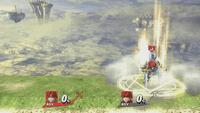
|
|---|
Taunts
- Up taunt: Triumphantly holds the Sword of Seals diagonally above his head.
- Side taunt: Winds back before striking a pose while holding the Sword of Seals in a reverse grip while saying "僕 は 負けない!" ("I won't lose!") This line was one of his victory quotes in Melee.
- Down taunt: Kneels and twirls the Sword of Seals behind himself while yelling "Heee-ya!" This taunt returns from Melee.
| Up taunt | Side taunt | Down taunt |
|---|---|---|
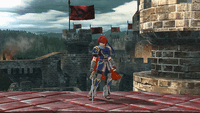
|
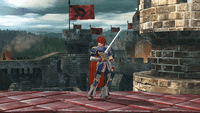
|
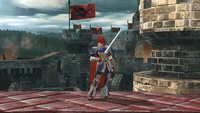
|
Idle poses
- Pumps his fist while smiling. Unusually, this is actually a part of his standing animation, and can be seen on the character customization screen, unlike other idle poses.
- Rubs the edge of the Sword of Seals' blade.
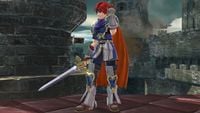 |
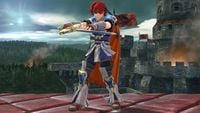
|
|---|
Crowd cheer
| English | Japanese | |
|---|---|---|
| Cheer | File:Roy Cheer NTSC SSB4.ogg | File:Roy Cheer JP SSB4.ogg |
| Description | Roy's our Boy! | Roy! Roy! Roy! |
| Pitch | Female | Female |
Victory poses
- Swings the Sword of Seals once over his shoulder, then swings it down and behind him while facing left with his free hand clenched, saying "真の戦いは、これからだ。" ("The real battle is yet to come.")
- Spins the Sword of Seals one and a half times and then sheaths it, saying "苦しい戦いだった。" ("That was a difficult battle.") This replaces his victory animation from Melee, where he plunged the Sword of Seals into the ground.
- Flourishes the Sword of Seals in a circle before posing with it by his side, saying "守るべきもののために、負けられない!" ("For the sake of those I must protect, I will not lose!")
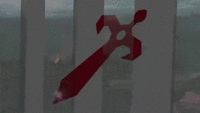 |
 |

|
|---|
In competitive play
Notable players
Active
Inactive
Neath - Formerly the best Roy player in France. Has since dropped him for Diddy Kong.
NEO
ZeRo
Sethlon
Tier placement and history
Roy's initial perception among the community was very positive; players almost immediately recognized his powerful offense due to the prominent strengths of his sweetspotted attacks, heavily damaging throw set-ups, and significantly improved mobility. These views were especially noted because his semi-clone, Marth, as well as Lucina, were considered poor characters at the time. Despite his extremely low representation, which is unseen of a perceived high-tier character, most of the community believed that Roy was a viable character, with ZeRo notably going as far as saying he was the best sword-wielding character in the game.
Even so, his viability was then disputed due to his poor tournament representation and results; furthermore, characters considered worse than him received a variety of buffs in later updates, with a corresponding increase in tournament results and representation than Roy, while his weaknesses were made much more apparent to the community. As such, opinions on Roy quickly started to change due to his vulnerability to combos, weak recovery, and how his playstyle forces him to approach as close as possible despite having a weak approach. In spite of these flaws and his poor representation and results, Roy was ranked 32nd on the first tier list, placing him at the top of the F tier and making him the highest ranked low-tier character.
However, update 1.1.4 granted Marth and Lucina major buffs that significantly increased their effectiveness, while Roy only gained minor landing lag decreases to his aerials. This resulted in them achieving improved results (most notably the former) from professionals and saw their opinions reassessed as those of a high-tier and a mid-tier character, respectively, whereas Roy remained a low-tier character. His position relative to the cast, however, was still disputed; some professionals like ZeRo reconsidered him to be on the lower end of the mid-tier, others like Abadango considered him one of the worst characters in the game. In spite of his poor tournament representation, he had received some results from the few professionals who do main him. The biggest upset occurred at Super Smash Con 2016, where Ryo used Roy at in an impressive, yet ironical two-game win streak over Abadango's Mewtwo, with Abadango later counterpicking Ryo's Roy with Rosalina & Luma and winning by a slim margin. These results, however, were not enough to repair Roy's negative perception, and subsequently saw Roy being ranked 50th on the second tier list, placing him at the bottom of the G tier and resulting in him plummeting from the top of the low-tier to the bottom of the low-tier.
All in all, Roy's standing relative to the cast remains among the most contentious of all characters to these days. While his tournament representation and overall results still remain poor overall, a big feat of three Roy players achieved Top 32 at Smash the Record 2016. Due to these aforementioned factors, Roy's overall viability is debatable and his tier placement is likely to become higher in the next tier list.
Trophies
- Roy
- Roy, the main character of Fire Emblem: The Binding Blade, returns for the first time since Melee! In The Binding Blade, Roy led the troops of Pherae into battle in his ailing father’s stead, and now he brings his speed and talent for short-range combat into this game. His sword, the Sword of Seals, is uniquely powerful at the base of the blade.
: Fire Emblem: The Binding Blade
- Roy (Alt)
His sword, the Sword of Seals, is uniquely powerful at the base of the blade. Flare Blade creates an explosion in front of Roy that can be charged by holding down the button. Take care, though, because at the highest levels of charge, Roy himself will catch fire and take damage! His side special, Double-Edge Dance, changes for each strike after the first depending on whether you hold up or down while attacking.
Flare Blade creates an explosion in front of Roy that can be charged by holding down the button. Take care, though, because at the highest levels of charge, Roy himself will catch fire and take damage! His side special, Double-Edge Dance, changes for each strike after the first depending on whether you hold up or down while attacking.
: Fire Emblem: The Binding Blade
- Critical Hit
For Roy’s Final Smash, he traps enemies in a circular swing of the blade, brings it up behind him, and then, in a blast of fire, brings the blade down for a powerful finisher! The downward attack is powerful on its own but doesn’t have much range, so make sure you’re close enough to hit your enemies with the full combo and really seal their fate!
For Roy’s Final Smash, he traps enemies in a circular swing of the blade, brings it up behind him, and then, in a blast of fire, brings the blade down for a powerful finisher! The downward attack is powerful on its own but doesn’t have much range, so make sure you’re close enough to hit your enemies with the full combo and really seal their fate!
Critical Hit (Roy)
Alternate costumes

| |||||||

|

|

|

|

|

|

|

|
Reveal trailer
<youtube>w8XIj05irtU</youtube>
Gallery
Roy's amiibo.
Using his new neutral attack on Captain Falcon.
Using Double-Edge Dance's third upward hit on Lucario.
Using Critical Hit, his Final Smash, on Lucario and Charizard.
Alongside Roy Koopa.
Alongside Zero Suit Samus and Wii Fit Trainer.
Using Flare Blade on Link.
Using his up taunt alongside male and female Robin.
Trivia
- Roy makes a few references to his home game:
- His forward smash resembles his regular attack as a Great Lord in The Binding Blade, to the point where the freeze frame upon landing is modeled after the exact frame as the ending blow of said attack.
- Counter's counterattack animation resembles his long-ranged basic attack animation with the Sword of Seals.
- His up taunt is based on the cutscene illustration from The Binding Blade where he draws the Sword of Seals for the first time.
- Roy's pose in his official art is nearly identical to his pose in his official art for Melee.
- Aspects of Roy's sound design have been carried over from Melee:
- All of his sourspotted attacks emit a punch/kick sound effect instead of a slashing sound effect.
- He uses different voice clips when using battering items.
- When he is dizzy, his corresponding voice clip loops constantly instead of playing only once.
- He uses more than one voice clip for his smash attacks.
- He only has one voice clip upon being KO'd.
- Roy's up smash, Flame Sword, shares the same name as Mega Man's forward aerial.
- Roy, Marth, and Cloud are the only characters to speak Japanese in every regional release of SSB4.
- If Roy's on-screen appearance occurs on one of the leaf platforms in Distant Planet, he will descend with the leaf, but the Sword of Seals will remain stationary in the air until it returns to Roy once the battle actually starts.
| Fighters in Super Smash Bros. 4 | |
|---|---|
| Veterans | Bowser · Captain Falcon · Charizard · Diddy Kong · Donkey Kong · Dr. Mario · Falco · Fox · Ganondorf · Ike · Jigglypuff · King Dedede · Kirby · Link · Lucario · Lucas · Luigi · Mario · Marth · Meta Knight · Mewtwo · Mr. Game & Watch · Ness · Olimar · Peach · Pikachu · Pit · R.O.B. · Roy · Samus · Sheik · Sonic · Toon Link · Wario · Yoshi · Zelda · Zero Suit Samus |
| Newcomers | Bayonetta · Bowser Jr. · Cloud · Corrin · Dark Pit · Duck Hunt · Greninja · Little Mac · Lucina · Mega Man · Mii Fighter (Mii Brawler · Mii Gunner · Mii Swordfighter) · Pac-Man · Palutena · Robin · Rosalina & Luma · Ryu · Shulk · Villager · Wii Fit Trainer |
|
| |
|---|---|
| Fighters | Marth (SSBM · SSBB · SSB4 · SSBU) · Roy (SSBM · SSB4 · SSBU) · Ike (SSBB · SSB4 · SSBU) · Lucina (SSB4 · SSBU) · Robin (SSB4 · SSBU) · Corrin (SSB4 · SSBU) · Chrom (SSBU) · Byleth (SSBU) |
| Assist Trophies | Lyn · Black Knight · Tiki |
| Stages | Castle Siege · Arena Ferox · Coliseum · Garreg Mach Monastery |
| Item | Killing Edge |
| Other | Sothis |
| Trophies, Stickers and Spirits | Trophies (SSBM · SSBB · SSB4) · Stickers · Spirits |
| Music | Brawl · SSB4 · Ultimate |
| Masterpieces | Fire Emblem: Shadow Dragon and the Blade of Light · Fire Emblem: Mystery of the Emblem |
